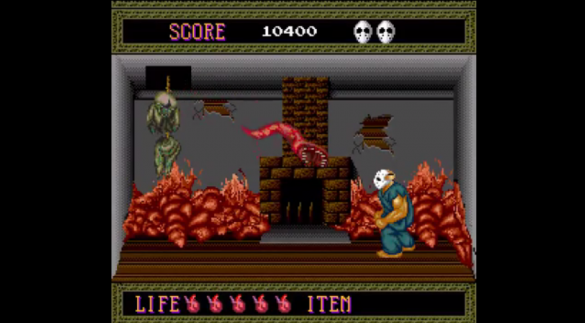
There can be little doubt that Splatterhouse is a child of its time. Alex has discussed in detail the thematic influences of late-80s cinema, though the mechanics of Namco’s schlock-action are equally indebted to the era’s arcade scene. Large sprites show off gruesome detail, demonstrating the power of Namco’s first 16-bit arcade board; however, in terms of pure gameplay, Splatterhouse was standard for the time – a left-right slog against punishing difficulty. Players were even bumped back to checkpoints upon death, preventing them from spamming through the game in 20p increments. Progress in Splatterhouse was not bought, it was earned.
Naturally, whilst the arcade version is the definitive edition, ownership outside a MAME library is difficult. Home versions include a US release on TurboGrafx-16, a Japanese variant on PC-Engine, alongside FM Towns and PC releases. The arcade, TG-16 and PC-E versions were tested here, though it is understood that the FM Towns release is virtually arcade perfect. The TG-16 game is available through the North American Virtual Console with the arcade original localized to the Japanese store. The TG-16 and PC-E conversions are less sadistically difficult with cosmetic changes that tone down the gore. Of the versions tested, the TG-16 release has more changes whilst the PC-E is the closest to the arcade original, however, the TG-16 Virtual Console version is the most accessible for Western audiences. The arcade original is also available as an unlockable extra in the 2010 series relaunch.
Gameplay wise, those big sprites have appropriately large hit-boxes that, when married to the clunky controls, render some sections an exercise in frustration. Difficulty comes from overwhelming the player, forcing them to simultaneously fight both the controls and the enemies. Perseverance solves this problem, but the underlying mechanics are neither rewarding nor engaging enough to warrant the effort. The restricted ‘left-right’ design constrains almost every aspect of Splatterhouse. With only a handful of attack patterns available for this gameplay, the enemy designs are limited and thus become repetitive, varying only by how many are faced at once. All told, Splatterhouse is a fine example of gore over substance and, to modern tastes, little more than a grotesque curio. There are not only better games than Splatterhouse, but better Splatterhouse games.


